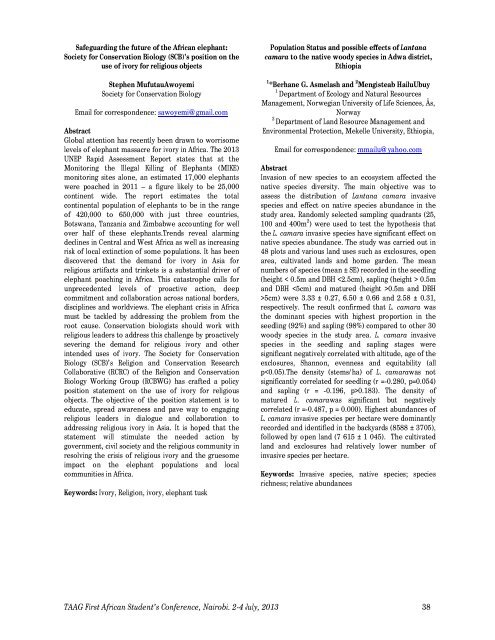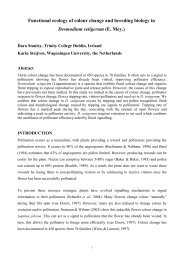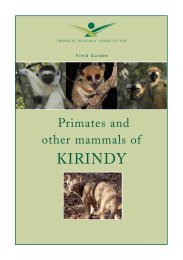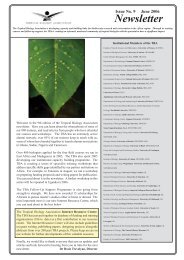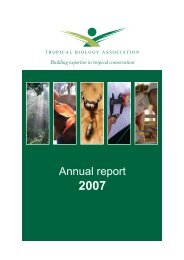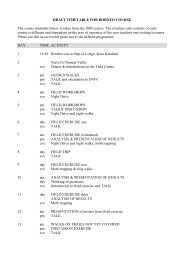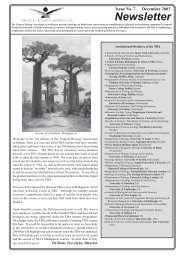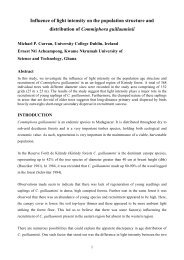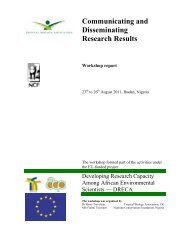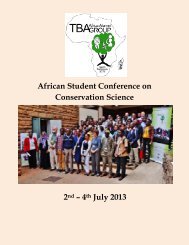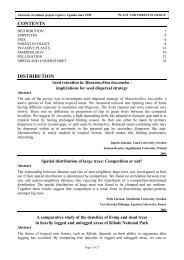Download TAAG Book of Abstracts - Tropical Biology Association
Download TAAG Book of Abstracts - Tropical Biology Association
Download TAAG Book of Abstracts - Tropical Biology Association
You also want an ePaper? Increase the reach of your titles
YUMPU automatically turns print PDFs into web optimized ePapers that Google loves.
Safeguarding the future <strong>of</strong> the African elephant:<br />
Society for Conservation <strong>Biology</strong> (SCB)'s position on the<br />
use <strong>of</strong> ivory for religious objects<br />
Stephen MufutauAwoyemi<br />
Society for Conservation <strong>Biology</strong><br />
Email for correspondence: sawoyemi@gmail.com<br />
Abstract<br />
Global attention has recently been drawn to worrisome<br />
levels <strong>of</strong> elephant massacre for ivory in Africa. The 2013<br />
UNEP Rapid Assessment Report states that at the<br />
Monitoring the Illegal Killing <strong>of</strong> Elephants (MIKE)<br />
monitoring sites alone, an estimated 17,000 elephants<br />
were poached in 2011 – a figure likely to be 25,000<br />
continent wide. The report estimates the total<br />
continental population <strong>of</strong> elephants to be in the range<br />
<strong>of</strong> 420,000 to 650,000 with just three countries,<br />
Botswana, Tanzania and Zimbabwe accounting for well<br />
over half <strong>of</strong> these elephants.Trends reveal alarming<br />
declines in Central and West Africa as well as increasing<br />
risk <strong>of</strong> local extinction <strong>of</strong> some populations. It has been<br />
discovered that the demand for ivory in Asia for<br />
religious artifacts and trinkets is a substantial driver <strong>of</strong><br />
elephant poaching in Africa. This catastrophe calls for<br />
unprecedented levels <strong>of</strong> proactive action, deep<br />
commitment and collaboration across national borders,<br />
disciplines and worldviews. The elephant crisis in Africa<br />
must be tackled by addressing the problem from the<br />
root cause. Conservation biologists should work with<br />
religious leaders to address this challenge by proactively<br />
severing the demand for religious ivory and other<br />
intended uses <strong>of</strong> ivory. The Society for Conservation<br />
<strong>Biology</strong> (SCB)’s Religion and Conservation Research<br />
Collaborative (RCRC) <strong>of</strong> the Religion and Conservation<br />
<strong>Biology</strong> Working Group (RCBWG) has crafted a policy<br />
position statement on the use <strong>of</strong> ivory for religious<br />
objects. The objective <strong>of</strong> the position statement is to<br />
educate, spread awareness and pave way to engaging<br />
religious leaders in dialogue and collaboration to<br />
addressing religious ivory in Asia. It is hoped that the<br />
statement will stimulate the needed action by<br />
government, civil society and the religious community in<br />
resolving the crisis <strong>of</strong> religious ivory and the gruesome<br />
impact on the elephant populations and local<br />
communities in Africa.<br />
Keywords: Ivory, Religion, ivory, elephant tusk<br />
Population Status and possible effects <strong>of</strong> Lantana<br />
camara to the native woody species in Adwa district,<br />
Ethiopia<br />
1 *Berhane G. Asmelash and 2 Mengisteab HailuUbuy<br />
1<br />
Department <strong>of</strong> Ecology and Natural Resources<br />
Management, Norwegian University <strong>of</strong> Life Sciences, Ås,<br />
Norway<br />
2<br />
Department <strong>of</strong> Land Resource Management and<br />
Environmental Protection, Mekelle University, Ethiopia,<br />
Email for correspondence: mmailu@yahoo.com<br />
Abstract<br />
Invasion <strong>of</strong> new species to an ecosystem affected the<br />
native species diversity. The main objective was to<br />
assess the distribution <strong>of</strong> Lantana camara invasive<br />
species and effect on native species abundance in the<br />
study area. Randomly selected sampling quadrants (25,<br />
100 and 400m 2 ) were used to test the hypothesis that<br />
the L. camara invasive species have significant effect on<br />
native species abundance. The study was carried out in<br />
48 plots and various land uses such as exclosures, open<br />
area, cultivated lands and home garden. The mean<br />
numbers <strong>of</strong> species (mean ± SE) recorded in the seedling<br />
(height < 0.5m and DBH 0.5m<br />
and DBH 0.5m and DBH<br />
>5cm) were 3.33 ± 0.27, 6.50 ± 0.66 and 2.58 ± 0.31,<br />
respectively. The result confirmed that L. camara was<br />
the dominant species with highest proportion in the<br />
seedling (92%) and sapling (98%) compared to other 30<br />
woody species in the study area. L. camara invasive<br />
species in the seedling and sapling stages were<br />
significant negatively correlated with altitude, age <strong>of</strong> the<br />
exclosures, Shannon, evenness and equitability (all<br />
p0.183). The density <strong>of</strong><br />
matured L. camarawas significant but negatively<br />
correlated (r =-0.487, p = 0.000). Highest abundances <strong>of</strong><br />
L. camara invasive species per hectare were dominantly<br />
recorded and identified in the backyards (8588 ± 3705),<br />
followed by open land (7 615 ± 1 045). The cultivated<br />
land and exclosures had relatively lower number <strong>of</strong><br />
invasive species per hectare.<br />
Keywords: Invasive species, native species; species<br />
richness; relative abundances<br />
<strong>TAAG</strong> First African Student’s Conference, Nairobi. 2-4 July, 2013 38


